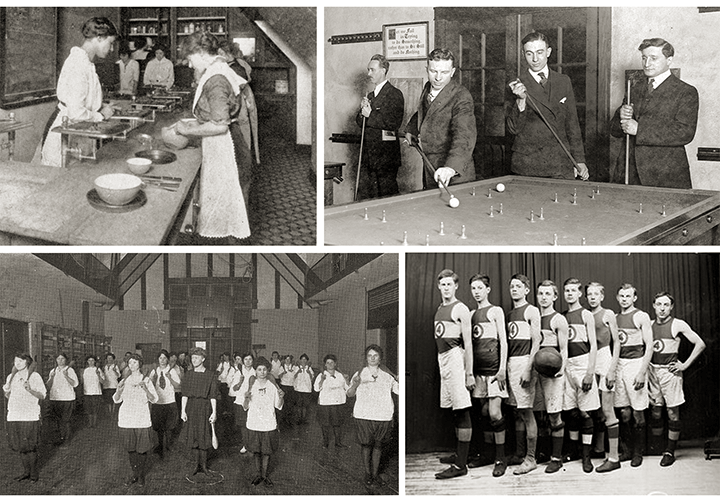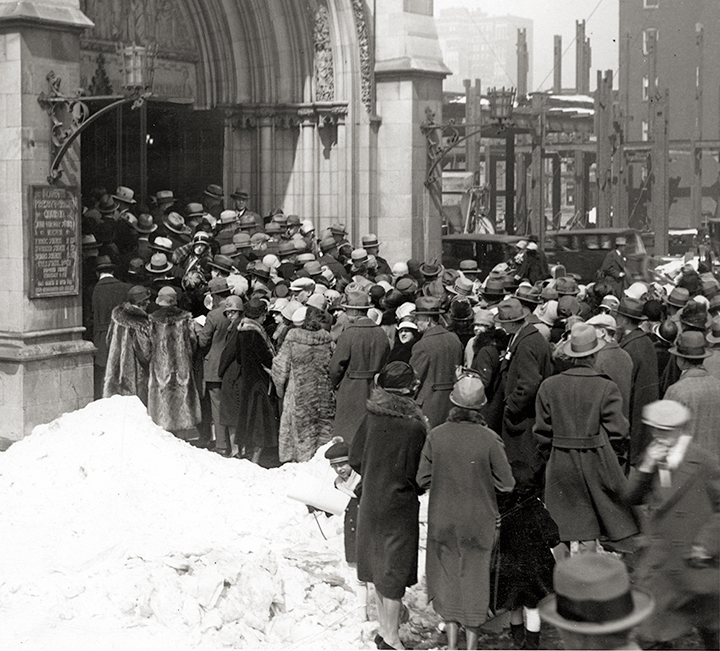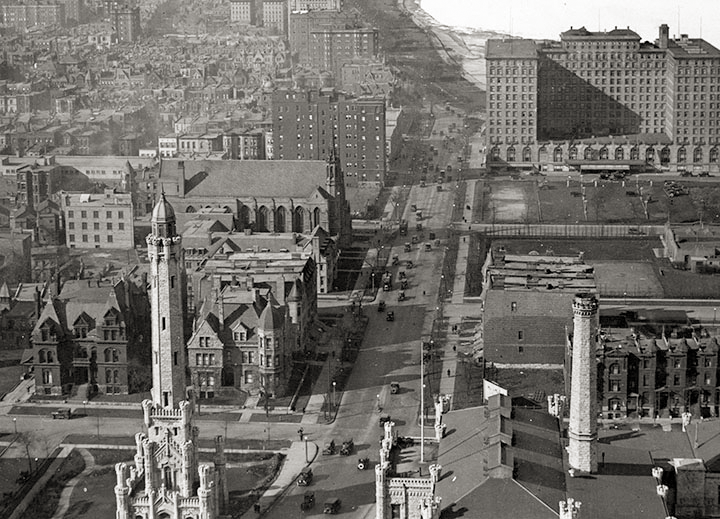“In all this city of three million souls I knew no one, cared for no one, was cared for by no one.”
—An unnamed young woman
Following the completion of a new church building and his yearlong term as Moderator of the Presbyterian Church in the USA in 1914, John Timothy Stone redoubled his efforts to grow the Fourth Church congregation through neighborhood outreach.
One neighborhood survey found there were between 15,000 and 18,000 men and women living within a half-mile of the new church building, many of whom were aspiring young professionals from out of town, like the unnamed young woman from the epigraph above. Stone wisely discerned Fourth Church could be their “home away from home.”

Some of the activities for young adults that Fourth Church was able to provide on its large new campus (clockwise from upper left): young women in a Domestic Science (cooking) class; young men in a billiard room; the Fourth Church boys’ basketball team (all of the jerseys have a “4” on them); a women’s exercise class in the second-floor gym.
This evangelism was temporarily diverted, however, when the United States became involved in World War I in 1917. Stone was an ardent supporter and recruiter for the war effort (using a religious patriotism many of us would be uncomfortable with today), and around 240 church members would go on to serve in the war—including Fourth Church’s young seminarian Harrison Ray Anderson, who corresponded with Stone from overseas.
Fourth Church continued to focus on its immediate neighborhood following the war, even as significant changes were taking place across the wider city. The early years of the Great Migration would more than double Chicago’s African American population between 1916 and 1920, leading to one of the most shameful events in the city’s history—the white-led 1919 Race Riots, which left dozens dead, hundreds injured, and more than a thousand African American families without homes.
In addition, the official start of Prohibition in 1920 soon resulted in staggering levels of organized crime in Chicago, much of which was aided and abetted by political corruption.
On both matters, John Timothy Stone and Fourth Church stayed conspicuously silent—choosing instead to focus on individual piety rather than directly addressing systemic issues like racism, injustice, or corruption. This emphasis on shaping individuals rather than society was also borne out through the church’s invitation committee, which Stone would later reflect “transformed the life of our church more than any other one agency.”
Committee members were active in recruiting young men and women from the boarding houses near the church, and a wealth of programs for young people and children began to spring up as church membership swelled—peaking (for a time) at 2,656 members in 1925.
In 1921, the church began a “Young People’s Church” involving more than one hundred children and youth—similar to our current Children’s Chapel, albeit with a formal usher corps and adult choral quartet leading the kids in song! Harold Dalzell and David Primrose were vital to the church’s ministry among young people, with Dalzell leading the Young People’s Church and an “1823 class” (for young adults aged 18–23) and Primrose recruiting kids on school playgrounds (a common practice back then, a big no-no today!) to attend church and Sunday School.
Between these efforts—and the flourishing of Sunday worship under Stone and organist and choir director extraordinaire Eric DeLamarter—the church succeeded at inviting hundreds of young men and women from the neighborhood through its doors.

Worshipers enter the Sanctuary on a snowy Easter morning in 1926 (visible in the background are the first girders for the second 900 North Michigan building, completed in 1927 and torn down in 1984).
As the 1920s roared on, however, the neighborhood surrounding the church began to shift under its feet. Although we associate the 1920s with speakeasys and gangsters, they were also a time of massive financial gain for some, and many of these newly wealthy individuals were choosing to settle down north of the recently opened Michigan Avenue bridge, buying up real estate and pushing the neighborhood’s boarding houses further west and north.
At the tail end of his tenure, Stone reflected, “Our church is so located that as the years go by we are becoming more and more a downtown church. Transient conditions surround us increasingly. . . . This last week out of some fifty or sixty calls made in this neighborhood I found that twenty-one families had moved [in the past three months].”

A 1924 photograph of North Michigan Avenue as viewed from the newly completed Allerton Hotel. In the lower left at Pearson and Michigan are the Farwell brothers’ mansions (built 1882); just north of the church was the original 900 North Michigan apartment building, which was there before the church was built but was torn down in 1925. Within five years the thirty-seven-story Palmolive building would be completed on the vacant lot at upper right, in front of the Drake Hotel.
The neighborhood had changed, membership growth had stagnated, and Stone recognized it was time for a change in leadership. In April 1928 he accepted a call to serve concurrently as President of McCormick Seminary—asking the congregation to take on a co-pastor who would eventually succeed him in full. His recommendation: Harrison Ray Anderson, Fourth Church’s former seminarian who had gone on to be a successful pastor in Kansas.
The thirty-six-year-old Anderson, like Stone before him, was uncertain about the call to serve as Fourth Church’s next pastor, but his ability to organize would prove to be an ideal complement to Stone’s ability to inspire. The two overlapped for a few years, but Anderson would waste no time putting his mark on church life and governance—as well as addressing some topics that Stone had largely left untouched.
• • •
< Back to Part 3 • On to Part 5 >